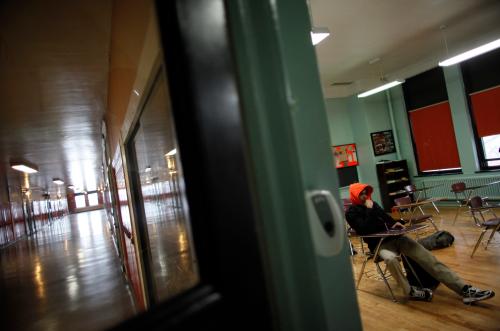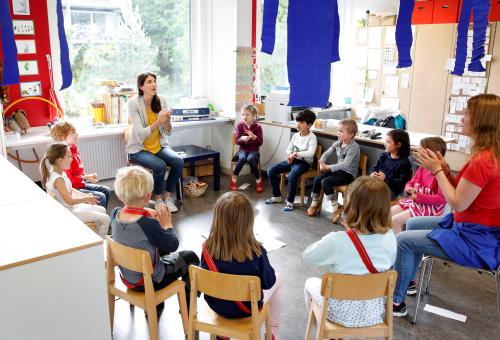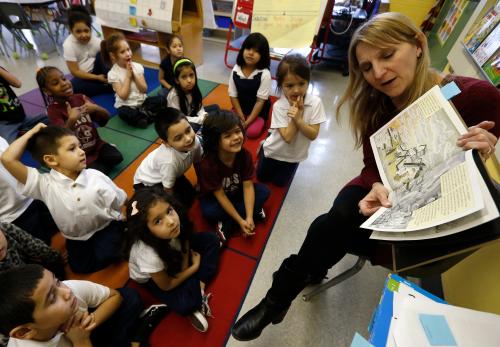Education leaders across the country have joined the chorus condemning the recent police killings of Black people. Statements released by superintendents and teachers’ unions suggest a reckoning with the institutional racism and bias embedded within schools. Some school districts have seized on this period of national reflection to propose actions and policy changes intended to reduce racial disparities in education and create anti-racist school systems.
Education scholars have hypothesized that implicit bias, or unconscious beliefs, may contribute to stubborn racial disparities in education, such as differences in student achievement and school discipline between Black and white students. For instance, teachers’ unconscious racial beliefs could produce biased evaluations of students’ academic performance, which translates into real implications for educational attainment. Yet evidence linking teachers’ bias to these disparities has been lacking.
In a study published in Educational Researcher this month, we examine teachers’ implicit biases and their correlates. Our findings, described in more detail below, largely confirm hypotheses that connect county-level teacher implicit bias to disparities in achievement and school discipline between Black and white students at the county level.
Measuring implicit bias requires tapping into implicit cognition—a difficult task. In our study, we leverage data from Project Implicit’s white-Black implicit association test (IAT). The white-Black IAT assesses test-takers’ automatic associations for white and Black people. The IAT identifies biases through a series of high-speed computerized tasks, which compare how quickly individuals associate white and Black people with certain attitudes (e.g., favorable, unfavorable). We pair these data with nationwide data on racial achievement gaps, made available by the Stanford Education Data Archive, and racial discipline gaps, made available by the Civil Rights Data Collection.
It is important to note that our research design does not allow us to definitively conclude that teachers’ biases cause racial disparities in student outcomes or identify the mechanisms behind the bias-outcome relationship. Still, the results described below persist even after accounting for important contextual factors (e.g., socio-economic status and segregation measures) and instructional factors (e.g., per-pupil expenditures and student/teacher ratio).
Our first key finding is that educators, like the general public, hold “slight” pro-white/anti-Black implicit bias and that this bias is more strongly related to individual factors than contextual factors. Teachers of color show lower average bias than white teachers, with Black teachers showing the least anti-Black bias. But teachers of color are a far smaller share of the teaching workforce than white teachers. Female teachers, who continue to substantially outnumber male teachers, show lower average bias. We also find that teachers working in counties with larger shares of Black students exhibit lower levels of implicit bias. This might be because teachers with lower bias prefer to work in counties with more Black students and/or that working in schools serving more Black students leads to lower bias. Regardless, there is some relief that we do not observe the reverse pattern.
Our second key finding is that we observe larger racial disparities in test scores and suspensions in counties with stronger implicit and explicit pro-white/anti-Black bias among teachers. In Figure 1, we plot predicted white-Black differences in test scores for counties with varying levels of teacher implicit bias (assuming average values on other contextual characteristics). The solid vertical line identifies counties with average teacher bias; in these counties, Black students score approximately 0.55 standard deviations (SDs) lower than white students on tests. Contrastingly, counties with “little or no” pro-White/anti-Black teacher bias lie to the left of the dashed vertical line; for these counties, test score differences range up to approximately 0.40 SDs. The predicted differences in disparities emerge even after accounting for several context-varying factors that contribute to achievement or opportunity gaps, including individual-based factors (e.g., poverty) and school-based factors (e.g., racial segregation). Unfortunately, very few counties exhibit low levels of teacher implicit bias: Of the 764 we analyze, only in seven were teachers, on average, demonstrating “little or no” pro-white/anti-Black bias.
Black students in counties where teachers hold average levels of bias also have predicted probabilities of being suspended that are far greater than those for Black students in counties with low pro-white/anti-Black bias.
In Figure 2, we show the predicted probabilities for in-school (left) and out-of-school suspensions (right) for Black and white students. Again, the solid vertical line identifies counties with average teacher bias and the dashed vertical line helps delineate those with low pro-white/anti-Black bias. In counties with average bias, we estimate that Black students have a 13% and 16% predicted probability of being suspended in and out of school, respectively, whereas white students have a 5% probability of being suspended either in or out of school. Meanwhile, Black students in counties with low teacher bias have up to an 8% predicted probability of being suspended both in and out of school, while white students have up to 2% and 4% suspension probabilities. These results are generally similar to those from a study published last year that examined implicit biases of the broader population and racial discipline gaps using a slightly different analytical approach.
Overall, our research suggests that teachers’ biases may contribute to the seemingly entrenched disparities in academic achievement and suspensions between Black and white students. Education reformers and policymakers have sought to reduce unequal outcomes for Black students for decades. Many of these efforts, even when undertaken by well-intentioned educators, have largely failed. The undercurrents of educator implicit bias could be part of the explanation as to why well-meaning reforms to address racial disparities have little to show for.
But addressing implicit bias is likely more complicated than requiring educators attend a training. In fact, recent evidence on interventions designed to reduce implicit bias show little overall impact on behavior. That may be because implicit bias has a large contextual component. According to some scholars of implicit bias, aggregate measures of bias, like the ones we use, are better thought of as measuring the psychological residue of structural racism (e.g., redlining and policing) rather than fixed attitudes that people hold regardless of the context. In other words, as long as structural racism looms large, implicit biases will too. Working to both dismantle the contextual factors that induce greater implicit bias and attending to individual teachers’ implicit attitudes is likely necessary for this most recent wave of action to realize its potential.
The Brookings Institution is committed to quality, independence, and impact.
We are supported by a diverse array of funders. In line with our values and policies, each Brookings publication represents the sole views of its author(s).











